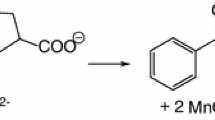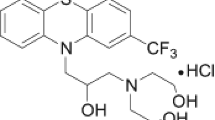Abstract
HLö 7, (pyridinium, 1-[[[4-(aminoarbonyl)pyridinio]methoxy]methyl]-2,4-bis-[(hydroxyimino)methyl] diiodide) has been shown to be efficacious in soman poisoning of mice, even in the absence of atropine. To assess possible risks involved in the administration of HLö 7 its degradation products were analyzed at pH 2.5 and pH 7.4, respectively. At pH 2.5, where HLö 7 in aqueous solution was assumed to possess maximal stability, the predicted shelf life (10% decomposition) was about 8 years for 10 mM solutions at 8° C. The apparent energy of activation was 117 kJ/mol. At pH 2.5, attack on the aminal-acetal bond predominated with formation of pyridine-2,4-dialdoxime, 2-cyanopyridine-4-aldoxime, isonicotinamide, and formaldehyde. At pH 7.4, primary attack on the 2-aldoxime group resulted in formation of an intermediate 2-cyano-4-aldoxime derivative which mainly decomposed into cyanide and the corresponding 2-pyridinone, 1-[[[4-(aminocarbonyl)-pyridinio] methoxy]methyl]-4-[(hydroxyimino)methyl] diiodide. In addition, liberated cyanide reacted with the intermediate 2-cyano-4-aldoxime derivative with formation of 2-pyridinone, 1-[[[4-(aminocarbonyl)-pyridinio]-methoxy] methyl]-6-cyano-4-[(hydroxyimino)methyl] diiodide. This cyanide sequestering pathway became significant only at high concentrations (10 mM) of HLö 7, and was marginal at 1 mM HLö 7.
Similar content being viewed by others
References
Bodenhausen G, Kogler H, Ernst RR (1984) Selection of coherence-transfer pathways in NMR pulse experiments. J Magn Res 58: 370–388
Boskovic B, Kovacevic V, Jovanovic D (1984) PAM-2 Cl, HI 6 and HGG 12 in soman and tabun poisoning. Fund Appl Toxicol 4(2): 106–115
Christenson I (1972) Hydrolysis of obidoxime chloride (Toxogonin) III. Kinetics in neutral and alkaline solution. Acta Pharm Suec 9: 309–322
Christenson I (1968)a Hydrolysis of bis-(4-hydroxiiminomethyl)ether dichloride (Toxogonin) Acta Pharm Suec 5: 23–36
Christenson I (1968)b Hydrolysis of bis-(4-hydroxiiminomethyl)ether dichloride (Toxogonin) II. Kinetics and equilibrium in acidic solution. Acta Pharm Suec 5: 249–262
Clement JG (1981) Toxicology and pharmacology of bis-pyridinium oximes. Insight into the mechanism of action vs soman poisoning in vivo. Fund Appl Toxicol 1(2): 193–202
Clement JG (1982) HI 6: Reactivation of central and peripheral acetylcholinesterase following inhibition by soman, sarin and tabun in vivo in the rat. Biochem Pharmacol 31(7): 1283–1287
Clement JG (1983) Efficacy of mono and bis-pyridinium oximes versus soman, sarin and tabun poisoning in mice. Fund Appl Toxicol 3(6): 533–535
Clement JG, Shiloff DJ, Gennings C (1987) Efficacy of a combination of acetylcholinesterase reactivators, HI 6 and obidoxime, against tabun and soman poisoning of mice. Arch Toxicol (1987) 61: 70–75
Ellin RI (1958) Stability of pyridine-2-aldoxime methiodide I. Mechanism of breakdown in alkaline solution. J Am Chem Soc 80: 6588–6590
Ellin RI, Carlese JS, Kondritzer AA (1962) Stability of pyridine-2-aldoxime methiodide II. Kinetics of deterioration in dilute aqueous solution. J Pharm Sci 51: 141–146
Eyer P, Hell W (1985) Chemical stability of the Hagedorn oximes HGG 12 and HI 6. Arch Pharm 318: 938–946
Eyer P, Hell W (1986) Untersuchung des Zerfalls von HGG 12 in wässriger Lösung. Arch Pharm 319: 558–566
Eyer P, Hell W, Kawan A, Klehr H (1986) Studies on the decomposition of the oxime HI 6 in aqueous solution. Arch Toxicol 59: 266–271
Eyer P, Kawan A, Ladstetter B (1987) Formation of cyanide after i.v. administration of the oxime HI 6 to dogs. Arch Toxicol 61: 63–69
Eyer P, Hagedorn I, Ladstetter B (1988) Study on the stability of the oxime HI 6 in aqueous solution. Arch Toxicol 62: 224–226
Gündel WH (1980) Notiz über Pseudobasen aus Pyridinium-alkoxiden. Liebigs Ann Chem 1350–1380
Gündel WH (1981) Untersuchungen an quartären Pyridinium-Salzen, XIV [1] Dihydropyridyl-oximether. Z Naturforsch 36b: 1031–1036
Gündel WH (1983) Untersuchungen an quartären PyridiniumSalzen, XV [1] Pseudobasen und Redoxprodukte bei der Umsetzung von Pyridinium-Salzen mit Alkoholat. Z Naturforsch 38b: 873–883
Hagedorn I, Stark I, Lorenz HP (1972) Reaktivierung phosphorylierter Acetylcholinesterase. Abhängigkeit von der Aktivatoracidität. Angew Chem 84: 354–356
de Jong LPA, Wolring GZ (1984) Stereospecific reactivation by some Hagedorn oximes of acetylcholinesterase from various species including man, inhibited by soman. Biochem Pharmacol 33(7): 1119–1125
Kuhnen H, Schrichten A, Schoene K (1985) Influence of atropine upon ageing and reactivation of soman inhibited acetylcholinesterase from human erythrocytes. Arzneimittelforsch 35(9): 1454–1456
Löffler M (1986) Quartäre Salze von Pyridin-2,4-dialdoxim als Gegenmittel für Organophosphatvergiftungen. Thesis, Freiburg/FRG
Lundy PM, Shih TM (1983) Examination of the role of central cholinergic mechanism in the therapeutic effects of HI 6 in organophosphate poisoning. J Neurochem 40(5): 1321–1328
Marcov V, Rakin D, Binenfeld Z (1984) Hidroliza 1-(2-hidroksiiminometil-1-piridinijum)-3-(4-karbamoil-1-piridinijum)-2-oksapropan dihlorida (HI 6). Ispitivanje, stabilnosti vodenih rastvora. Naucno-technicki Pregled 34: 19–24
Pilipovic I, Vucusic I (1983) Stability of the oxime HI 6 in acidic solutions. Abstract of the Second International Meeting on Cholinesterases, Bled
Sket D, Brzin M (1986) Effects of HI 6 applied into the cerebral ventricles, on the inhibition of brain acetylcholinesterase by soman in rats. Neuropharmacology 25(1): 103–107
Stark I (1971) Reaktivierung phosphorylierter Acetylcholinesterase mit quarternierten Pyridinaldoximen: Ermittlung eines Zusammenhangs zwischen Oximacidität und Reaktivierungsvermögen. Thesis, Freiburg/FRG
Wolthuis OL, Vanwersch RAP, van der Wiel HJ (1981) The efficacy of some bis-pyridinium oximes as antidotes to soman in isolated muscles of various species including man. Eur J Pharmacol 70(30): 355–369
Author information
Authors and Affiliations
Additional information
Part of PhD-Thesis, Universität München
Rights and permissions
About this article
Cite this article
Eyer, P., Ladstetter, B., Schäfer, W. et al. Studies on the stability and decomposition of the Hagedorn-oxime HLö 7 in aqueous solution. Arch Toxicol 63, 59–67 (1989). https://doi.org/10.1007/BF00334636
Received:
Revised:
Accepted:
Issue Date:
DOI: https://doi.org/10.1007/BF00334636




